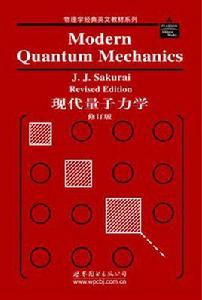內容提要
本書作者Sakurai是一位傑出的理論物理學家和粒子物理學家。本書對於量力學概念的介紹與傳統的做法不同,沒有受制於量子力學發展的歷史線索,力求從一開始就擺脫經典力學的束縛。它直接從量子力學特有的電子自旋的觀測實驗出發,圍繞其狀態的機率特徵和疊加原理展開對於量子力學基本概念和基本原理的闡述。從空間平移、空間轉動及時間演化等對稱性變換出發,引入動量、角動量及哈密頓算符等基本力學量,討論它們的本徵值問題,它們的運動方程及與經典力學的關係,從而直接切入量子力學的核心問題。這種被稱之為“用量子力學方式來思考”的做法貫穿全書,是本書最引入矚目之處。
國內已經出版了不少高等量子力學的教材,但與之直接對應的國外教材卻並不多見。本書從其設定的讀者對象、它的選材範圍以及其深度與廣度來看,都非常適合這方面的要求。如果從雙語教學角度來考慮,它無疑也是理想教材的候選者。
作者簡介
Jun John Sakurai,was born in1993in Tokyo and came to the United States as a high school student in 1949.He studied at Harvard and at Cornell,where he received his h.D. in 1958.He was then appointed assistant professor of Physics at the University of Chicago,and became a full professor in 1964.He stayed at Chicago until 1970 when he moved to the University of California at Los Angeles,Where he remained until his death.During his lifetime he wrote 119 articles in theoretical physics of elementary particles as well as several books and monographs on both quantum and particle theory.
目錄
Contents
Foreword
Preface
In Memoriam
1 FUNDAMENTAL CONCEPTS
1.1 The Stern-gerlach Experiment
1.2 Kets,Bras,and Operators
1.3 Base Kets and Matrix Representations
1.4 Measurements,Observales,and the Uncertainty Relations
1.5 Change of Basis
1.6 Position,Momentum,and Translation
1.7 Wave Functions in Postion and Momentum Space
Problems
2 QUANTUM DYNAMICS
2.1 Time Evolution and the Schrodinger Equation
2.2 The Schrodinger Versus the Heisenberg Picture
2.3 Simple Harmonic Oscillator
2.4 Schrodingers Wave Equation
2.5 Propagators and Feynman Path Integrals
2.6 Potentials and Gauge Transformations
Problems
3 THEORY OF ANGULAR MOMENTUM
3.1 Rotations and Angular Momentum Commutation Relations
3.2 Spin1/2 Systems and Finite Roations
3.3 SO(3),Su(2),and Euler Roations
3.4 Density Operators and Pure Versus Muixed Ensembles
3.5 Eigenvalues and Eigenstates of Angular Momentum
3.6 Orbital Angular Momentum
3.7 Addition of Angular Momenta
3.8 Schwinger s Oscillator Model of Angular Momentum
3.9 Spin Corelation Measurements and Bell s Inequality
3.10 Tensor Operators
Problems
4 SYMMETRY IN QUANTUM MECHANICS
4.1 Symmetries,COnservation Laws and Degeneracies
4.2 Discrete Symmetries,Parity,or Space Inversion
4.3 Lattice Translation as a iscrete Symmetry
4.4 The Time-Reversal Discrete Symmetry
Problems
5 APPROXIMATION METHODS
5.1 Time-Independent Perturbation Theory:Nondegenerate Case
5.2 Time-Independent Perturbation Theory:The Degenerate Case
5.3 Hydrogenlike Atoms:Fine Structure and the Zeeman Effect
5.4 Variational Methods
5.5 Time-Dependent Potentials:The Interaction Picture
5.6 Time-Dependent Perturbation Theory
5.7 Applications to Interactions with the CLassical Radiation Field
5.8 Energy Shift and Decay Width
Problems
6 IDENTICAL PARTICLES
6.1 Permutation Symmetry
6.2 Symmetrization Postulate
6.3 Two-Electron System
6.4 The Helium Aton
6.5 Permutation Symmetry and Young Tableaux
Problems
7 SCATTERING THEROY
7.1 The Lippmann-Schwinger Equation
7.2 The Born Approximation
7.3 Optical Theorem
7.4 Eikonal Approximation
7.5 Free-Particle States:Plane Waves Versus Spherical Waves
7.6 Method of Partial Waves
7.7 Low-Energy Scattering and Bound States
7.8 Resonance Scattering
7.9 Identical Particles and Scattering
7.10 Symmerty Considerations in Scattering
7.11 Time-Dependent Formulation of Scattering
7.12 Inelastic Electron-Atom Scattering
7.13 Coulomb Scattering
Problems
AppendixA
AppendixB
AppendixC
SupplementⅠ Adiabatic Change and Geometrical Phase
SupplementⅡ Non-Exponential Decays
Bibliography
INdex

